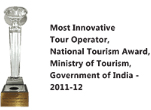Day 1 (Sunday):
Arrive Guwahati Airport & board MV Mahabaahu
Fly in to Guwahati by 1100 hrs. where the representatives of MV Mahabaahu receive us and we drive away to Kamakhya Temple. After a visit to the Goddess of Desire we drive to MV Mahabaahu.
We are welcomed and ushered in to our cabins and soon after we enjoy lunch on board.
We peel away from the Saraighat Bridge that supports a rail and a road and marks the narrowest stretch of Brahmaputra. We sail past the Peacock Island and notice the hills around Guwahati that make it picturesque. We use the afternoon to settle in and this evening we gather on the Sun Deck.
We use the afternoon to settle in and this evening we gather on the Sun Deck.
We raise a toast to the River Brahmaputra and enjoy this sundowner and look out for the Gangetic Dolphins that hunt in these deep waters.
Soon after we gather for a safety briefing and a presentation on the ship’s facilities as we sip on Assam tea. This evening we gather in the lounge for drinks and move on for a sit-down Chef’s Welcome Dinner in the Ship’s Restaurant ‘Mungri Mungram’.
We are briefed on the program for the following day once again. Some guests continue on, in the Lounge after Dinner and others retire for the day.
Overnight on board MV Mahabaahu (L, D)
Day 2 (Monday):
A Bangla Village Visit,
A laid-back relaxed breakfast from 0800 to 1000 hrs, a talk on Kamakhya Temple and an orientation on the Bangla Village. We interact with the village folk and try to understand the simple and satisfied subsistence life styles. These folks who live off the Brahmaputra River, both for farming and fishing make a choice of living on fertile unclaimed sand bars. They understand that they can enjoy the privilege of owning large expanse of land only till the river decides to remain benevolent. The river claims their land during the monsoon and they must return to their haven on mainland or create one. The river starts receding from October to mid-Feb and slowly the snow-melt in the Himalayas starts creating volume and an indication to get ready. April showers add to the water levels.
We return to the ship for lunch and enjoy some leisurely hours reading a book or indulging in a steam, Sauna, Jacuzzi or an Ayurvedic Massage or any other treatment. You can enjoy a dip in the swimming pool or be on the sun deck to enjoy the river in its process of devouring or adding to the sand of the sand bars.
In the evening, along with some ‘chai and pakoras’, an ethnic Indian snack, we enjoy a talk on ‘Assam, its geographical location, the role of River Brahmaputra, the tribal life and commercial Ventures; Tea, Silk & Jute that Assam is famous for’.
Overnight on board MV Mahabaahu (B, L, D)
Day 3 (Tuesday):
Jeep Safari Through The Panapur Range Of Kaziranga National Park
A relaxed cup of coffee or Assam tea, some Yog and a laid- back leisurely breakfast followed by a talk on ‘Kaziranga and wildlife in India’ and orientation on ‘Kaziranga Park Visit’. We sail along Singri and Tezpur and under the Kaliabhamura bridge and reach Silghat where the ship docks.
After an early lunch We then drive for an hour to the Panpur Range of the Kaziranga National Park for an afternoon jeep safari exploring this in-land range teaming with rhinos, wild buffaloes, elephants, swamp deer, wild boar and many birds. An evening Dance of Assam, ‘Bihu’ by young village boys and girls and return to the ship. We enjoy the evening in the lounge and then have a leisurely time in the dining enjoying the cuisine for the day. Book your wake-up calls at the reception for the following morning early start.
Overnight on board MV Mahabaahu (B, L, D)
Day 4 (Wednesday):
Kaziranga National Park / Sail
Very early today drive towards the Kaziranga National Park. Start our morning adventure with once-in-alifetime elephant safari (Optional). After breakfast at a resort in Kaziranga, we get into the open jeeps for some more wildlife adventure and an extensive coverage of this magnificent park.
This afternoon we board the ship at 1200 hrs, enjoy lunch and settle in for a restful afternoon. For those of us who like to watch the world go by, we make ourselves comfortable on the sun-deck as the ship sails towards Diphlu.
Overnight on board MV Mahabaahu (B, L, D)
Day 5 (Thursday):
Bishwanath Ghat Weaving Village / Boat Safari at The Eastern Range of Kaziranga
We sail very early towards Bishwanath Ghat. Breakfast and an orientation on Bishwanath Ghat, Boat Safari and Mishing Village. We visit this tiny sub-urban village on the banks of Brahmaputra and sprinkled with temples and is a cosmos of weavers, fishermen, farmers and boat makers.
The sound of the shuttle on tense warp and raised alternate weft moving back and forth is music to the weavers of this community. A Shiva Dol (temple) from the times of Ahoms looms over and a promenade along the outcrop of rocks and swinging country boats adds beauty to the area. The weavers display their stories on their colourfully woven fabric and wait in anticipation. We return to the ship for lunch and sail on towards the Eastern Range (Agoratoli) to explore the Eastern Range of Kaziranga and view the wildlife from the river side.
This evening we return to the Ship at Sunset. The Chef is ready with his cooking demo when we step on the ship.
Overnight on board MV Mahabaahu (B, L, D)
Day 6 (Friday):
Mishing Village/Assamese Theme Evening
Yog, a good breakfast and leisurely hours of the morning to enjoy the sail. We sail on to the Mishing Village to witness life on Chang Ghars of Bamboo scaffolding, bamboo roofs and matted bamboo walls. The Mishing women arrange their looms beneath their raised homes and weave bright and colourful ethnic designs in their waft and warp. This village provides an opportunity to add Mishing woven fabric to your wardrobe or home décor.
We return to the ship for lunch and the sail continues upstream towards Majuli. After some sail, siesta and sunset we meet for a talk on Shivsagar and Majuli along with the orientation on these visits together with the home-hosted lunch at a tea-estate with a Planter’s family. This evening we enjoy an Assamese theme evening; Assamese freshly caught, fried fish for snacks, Assami Mekhla Chaadar and Dhoti Kurta with Ahomia music and Ahomia dance moves and to top it all an Assamese Dinner Menu.
Overnight on board MV Mahabaahu (B, L, D)
Day 7 (Saturday):
Majuli Island / Shivsagar
An early breakfast and we sail out to Majuli in the tenders to experience the neo-Vaishnav culture of the world’s largest inhabited riverine island. We enjoy Gayan Bayan by the priests. We drive to a different part of Majuli to watch Dashavatar by young Vaishnav girls and an episode from Ramayana-Mukha Bhavana.
These performances are a peep into the varied and rich culture of Assam. We return to MV Mahabaahu for lunch and sail to Neamati Ghat. If we are not too tired, we can undertake another road excursion to Shivsagar to Understand the history of Assam through the Ahom monuments or else we can indulge in an hour and a half of nature walk on the bund of Neamati Ghat to discover more rural life and some birds that nest along a rain-fed swamp.
The Group that goes to Shivsagar will return by 1900 hrs. and the others can enjoy an hour in the lounge. We look forward to the Chef’s ‘Alvida Bhoj’, Farewell Dinner on the river Brahmaputra.
Overnight on board MV Mahabaahu (B, L, D)
Day 8 (Sunday):
Nature Walk, Home-hosted lunch with a Tea Planter’s Family & Airport Departure from Jorhat
This day the nature enthusiasts wake up early to enjoy a walk on the Bund at Neamati Ghat. This is a walk through a narrow village where the huts/homes have sprouted along the two sides of a 12 ft. wide bund. The bund has the Brahmaputra River on one side and a monsoon or rainwater swamp on the other side making it an ideal space for bird life. Owls, owlets, orioles, quails, partridges, adjutant stalks and woodpeckers are an integral part of this space. Star fruit, wild figs, bananas, tamarind trees abound in the area.
At this early hour one can see the village waking up, milking cows, gardening, farming, children in uniform cycling to school and the fishermen fishing out their fresh catch from the net. This walk is an informal way of
peeping into the simple unpretentious Assamese village life.
We return to the ship for an early morning breakfast and we de-board the ship at 0900hrs to drive to a tea estate for a home-hosted early lunch prior to boarding the flight.
At the tea estate we meet the Planter’s family that has been in the tea-business for over a century, enjoy a tea-talk with professionals and walk around the Planter’s residence; the tea-estate that supports several herbs.
After a delicious home hosted ethnic Assamese lunch and warm hospitality, we bid farewell to the hosts and drive to the airport to board the flight.
—-Shubh Yatra / Bon Voyage—-
(B, L)



























